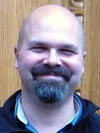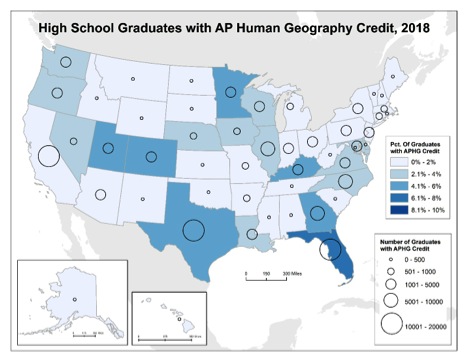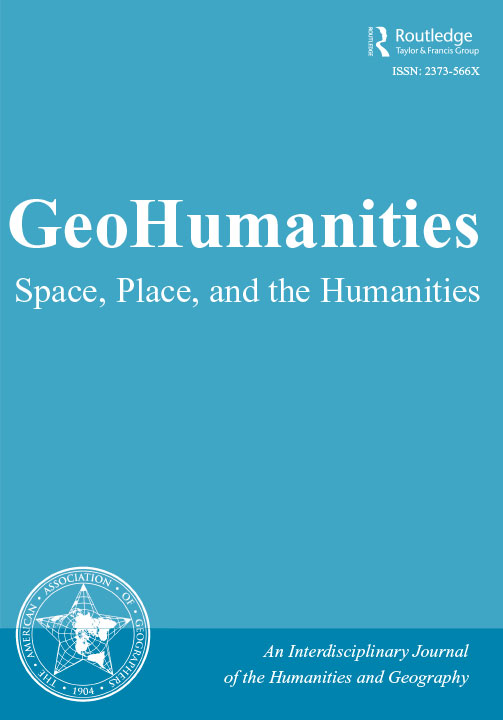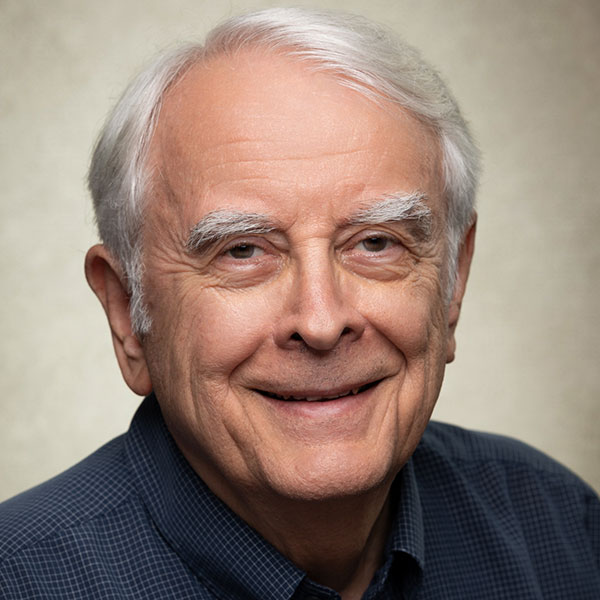A Golden Opportunity for Geography or How Can We Harness the Growth in AP Human Geography?

I am from a generation when high school classes (at least in my urban public school) were not terribly challenging. This was through no fault of the teachers, who had to contend with a broad range of students and overcrowded classrooms, but it meant that many of us coasted through high school, only to be stunned by the difficulty of our first college classes. As for geography—Fuhgeddaboudit! Geography was not taught in my high school and I expect that was true in much of the United States.1
Things have changed. Dual enrollment programs now allow high school students to attend their local college or university and receive credit at both institutions. This used to be a major hassle and now is a breeze. And high schools themselves offer many more Advanced Placement courses and exams. The AP program was still pretty small potatoes in most school districts until the 1980s and 1990s when the number of schools providing at least one AP course doubled and then tripled. AP courses are now available in well over half of US high schools—an outlet for students wishing to take rigorous courses plus obtain college credit if they score well on the AP exam.
The foresight of a few geographers and the extraordinary assistance of the AAG enabled us to develop an exam for AP Human Geography in the 1990s.2 Today AP Human Geography is the fastest growing AP course, increasing five-fold over the past 10 years. It is one of the 10 highest enrolled of all AP subjects. No longer folded into “social studies” or “earth science,” geography—at least human geography—finally has a place of its own in the secondary school curriculum.
AP Human Geography introduces whole cohorts of K–12 educators to geography, perhaps even expanding the numbers of education majors who decide to concentrate in this discipline. It provides a bit of extra pay and fellowship for the nearly 1,000 geography teachers, professors and grad students who descend on Cincinnati every June for the annual APHG grading. This event and others foster greater interactions between high school teachers and college faculty, expanding the community of geography.
That being said, the AP program and APHG has come under its share of criticism, and I want to address two points here. The first questions whether the AP Human Geography curriculum is as rigorous as the same course in college. Not surprisingly, this is echoed for all AP courses; some universities have even refused to accept AP credit as a consequence. I believe that such concerns are unfounded. True, many AP Human Geography teachers did not major in Geography, but the same could be said of many instructors brought in to teach at the college level. The textbooks are the same, and the AP Human Geography curriculum is well thought out and comprehensive. In addition, AP Human Geography courses are taught over an entire year, allowing for a great deal more content. In order to obtain any college credit at all students must score a 3 or better on the AP exam. In 2019, only about half of all students who took the APHG exam scored a 3, 4, or 5—scores required to get college credit. The other half of test-takers effectively “failed” the exam. Show me a college class where half the students fail, and I will show you a class where the instructor has been replaced. AP tests are tough, and the grading is far tougher than what students experience in college. Research results show that these AP students performed better in subsequent geography courses than did those students who took Human Geography in college.
The second critique has to do with whether AP Human Geography effectively cannibalizes college geography courses, as incoming students no longer need human geography as part of their distribution requirements. This may deserve some study and practice on how to move these students into other geography courses. But this possibility may be more than offset by using this one course to spearhead a Geography major or minor. Research for other AP subjects has shown a strong relationship between how well students perform in an AP subject and their likelihood of majoring in that subject in college.
In a previous column, I spoke about trends in Geography majors. Given this spectacular growth in AP Human Geography we would expect a similar trajectory for Geography majors, with a 5–7 year lag. But this is not the case. The number of Geography majors has remained flat even as successful APHG test takers have zoomed. One reason could be the preponderance of APHG as a 9th grade subject, as students who take it go on to other fields because the high schools offer no additional geography opportunities.
This is probably not going to change. But it represents a path of opportunity for all colleges and university Geography departments. At the larger level, inviting AP Human Geography teachers to special conference activities can be eye opening and inspiring for all. Since 2015, the American Geographical Society has held the Geography Teacher Fellows Initiative that, among other things, invites Human Geography teachers to their annual Geography2050 Symposium in New York, including special workshops and year-round activities to continue the engagement. The AAG has also initiated an APHG meeting at the AAG annual meeting. This comes with a special price for teachers to attend and allows for more workshopping and networking. We are now also introducing some of these workshops to regional meetings, with a few to be piloted this fall and hopefully a more comprehensive roll-out in 2020. There has been more energy around this issue than I have ever seen before, and it can help provide training, connections, and a sense of community for all Human Geography teachers.3
Beyond these initiatives, I propose taking steps at a smaller level. All geography departments are situated among numerous high schools, several of which teach AP Human Geography. The map below4 shows the numbers and relative percentages of students earning credit in the course by state. Clearly some states—notably Texas and Florida—have robust programs, mainly because they require more of their students to take AP courses. But many other states are catching up. The high school closest to me just initiated an AP Human Geography course three years ago and it is quite popular.

While these data are quite general, there are a couple of ways for interested faculty to acquire information more specific to them. One option is to look up the high schools teaching APHG in your state, and create some connections between the teachers, their class, and your department. Perhaps invite teachers and students to come over for Geography Awareness Day, or ask if you can talk with their class about what a geography degree has to offer. One PhD student has already piloted such a program to connect AP Human Geography high school teachers with Geography departments from local colleges and universities. Since many colleges and universities gain their students from neighboring communities, this early intervention could yield benefits further down the line.
Another option is to find those students who have completed APHG at your institution and then invite them to come to departmental events and to consider becoming a major or a minor. These data are not available publicly, but the names of such students can be requested from the Registrar’s office. I tried this myself, and while it required a bit of paperwork, it was ultimately successful.
Not one of these ideas is a magic bullet. Building up connections and enrollment can be a long and drawn-out process. But small steps might allow us to take advantage of something truly spectacular. We can seize this golden opportunity and invigorate geography throughout higher education. In this instance, I would love to hear of any successes AAG members have had with connecting to AP Human Geography.
— Dave Kaplan
AAG President
DOI: 10.14433/2017.0061
- In those more enlightened education systems outside the US, geography was and continues to be a vital subject in secondary school.
- A few useful sources relating this history and current prospects: Murphy (2000), Scholz (2014), Lanegran and Zeigler (2016), Bednarz (2016)
- This only applies to Human Geography, but we may also consider how to engage teachers of AP Environmental Science.
- Map created by Jessica Reese, based on data from the College Board and the US Census. Inspired by the maps and analysis in Jones and Luna (2019).


